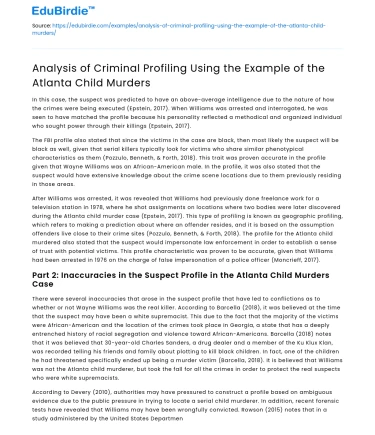In this case, the suspect was predicted to have an above-average intelligence due to the nature of how the crimes were being executed (Epstein, 2017). When Williams was arrested and interrogated, he was seen to have matched the profile because his personality reflected a methodical and organized individual who sought power through their killings (Epstein, 2017).
The FBI profile also stated that since the victims in the case are black, then most likely the suspect will be black as well, given that serial killers typically look for victims who share similar phenotypical characteristics as them (Pozzulo, Benneth, & Forth, 2018). This trait was proven accurate in the profile given that Wayne Williams was an African-American male. In the profile, it was also stated that the suspect would have extensive knowledge about the crime scene locations due to them previously residing in those areas.
Save your time!
We can take care of your essay
- Proper editing and formatting
- Free revision, title page, and bibliography
- Flexible prices and money-back guarantee
After Williams was arrested, it was revealed that Williams had previously done freelance work for a television station in 1978, where he shot assignments on locations where two bodies were later discovered during the Atlanta child murder case (Epstein, 2017). This type of profiling is known as geographic profiling, which refers to making a prediction about where an offender resides, and it is based on the assumption offenders live close to their crime sites (Pozzulo, Benneth, & Forth, 2018). The profile for the Atlanta child murdered also stated that the suspect would impersonate law enforcement in order to establish a sense of trust with potential victims. This profile characteristic was proven to be accurate, given that Williams had been arrested in 1976 on the charge of false impersonation of a police officer (Moncrieff, 2017).
Part 2: Inaccuracies in the Suspect Profile in the Atlanta Child Murders Case
There were several inaccuracies that arose in the suspect profile that have led to conflictions as to whether or not Wayne Williams was the real killer. According to Barcella (2018), it was believed at the time that the suspect may have been a white supremacist. This due to the fact that the majority of the victims were African-American and the location of the crimes took place in Georgia, a state that has a deeply entrenched history of racial segregation and violence toward African-Americans. Barcella (2018) notes that it was believed that 30-year-old Charles Sanders, a drug dealer and a member of the Ku Klux Klan, was recorded telling his friends and family about plotting to kill black children. In fact, one of the children he had threatened specifically ended up being a murder victim (Barcella, 2018). It is believed that Williams was not the Atlanta child murderer, but took the fall for all the crimes in order to protect the real suspects who were white supremacists.
According to Devery (2010), authorities may have pressured to construct a profile based on ambiguous evidence due to the public pressure in trying to locate a serial child murderer. In addition, recent forensic tests have revealed that Williams may have been wrongfully convicted. Rowson (2015) notes that in a study administered by the United States Department of Justice, members of the FBI, the Innocence Project, and the National Association, it was found that approximately 96% of cases involving a FBI hair analysis resulting in a conviction prior to 1999 were deemed faulty. In fact, one of those cases in which the evidence revealed to be faulty was the Wayne Williams case.
Conclusion
Criminal profiling is fairly recent investigative tool that is utilized to identify the characteristics of a suspect in order to create a profile. The major research findings I discussed in the paper was that profiling should be tested using statistical modelling in order to establish validity, and profiling should be constructed using forensic or physical evidence in order to develop a more concrete prediction about the suspect in question. The major controversies I discussed in the paper were that profilers often rely on the notion that offenders possess an inherent uniformity which may not always be proven to be true, and there is insufficient research to suggest that profiling has made a significant impact within the field of serial crimes. In the second portion of the paper, I examined criminal profiling using the example of the Atlanta child murders, a case involving a series of killings targeting African-American children during the early 1980s.
In the paper, I discussed how law enforcement was accurate in identifying key characteristics in order to construct the profile, such as his age, race, and geographic location. I also discussed how the profile of Wayne Williams had some inaccuracies, where it was believed that the true suspect may have been a white supremacist, but Williams was quickly convicted due to the pressure placed on law enforcement by the public to arrest a serial killer targeting children. While criminal profiling does not seem to be a technique that law enforcement should solely rely on when trying to identify a suspect, it does seem to act as a viable predicting method in determining the characteristics of a suspect that can be used in order to prevent future crimes from occurring.






 Stuck on your essay?
Stuck on your essay?

